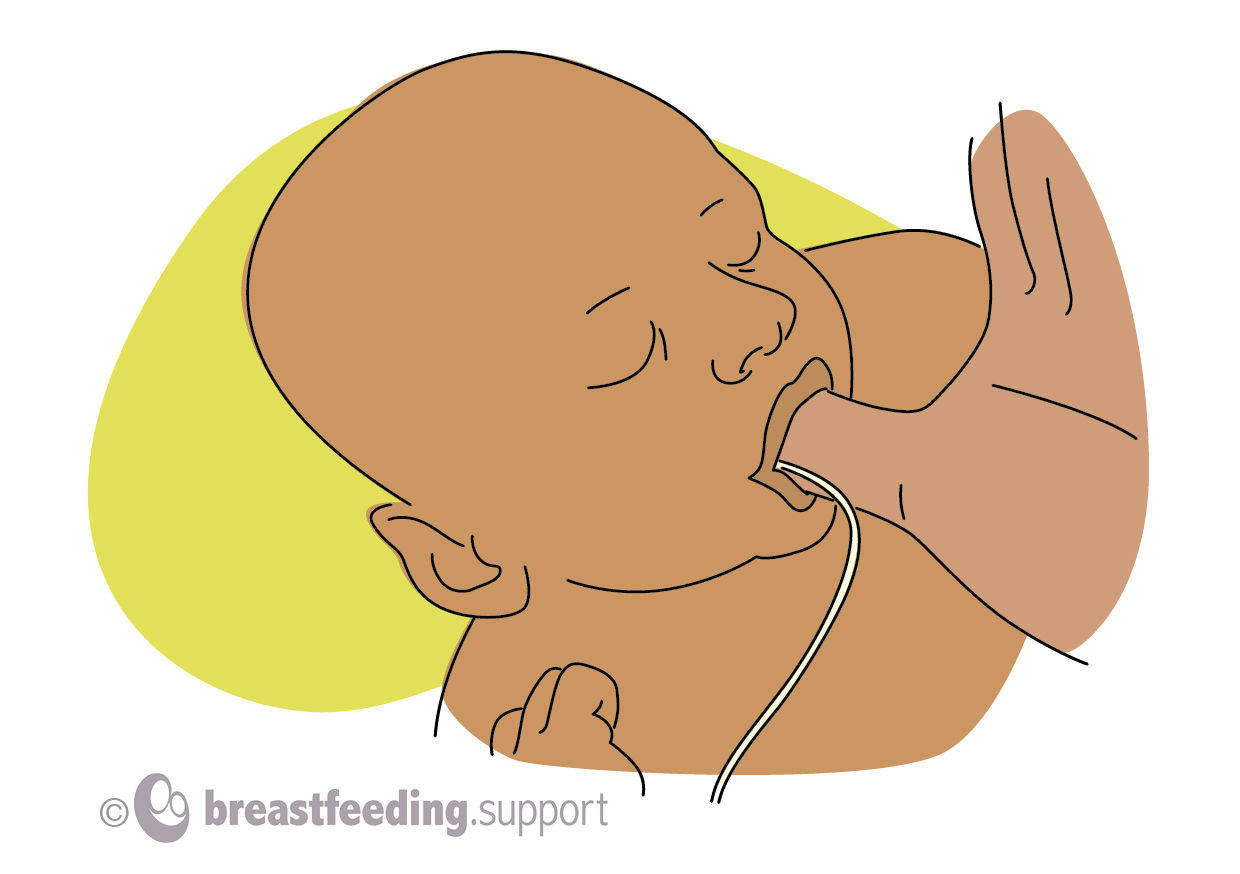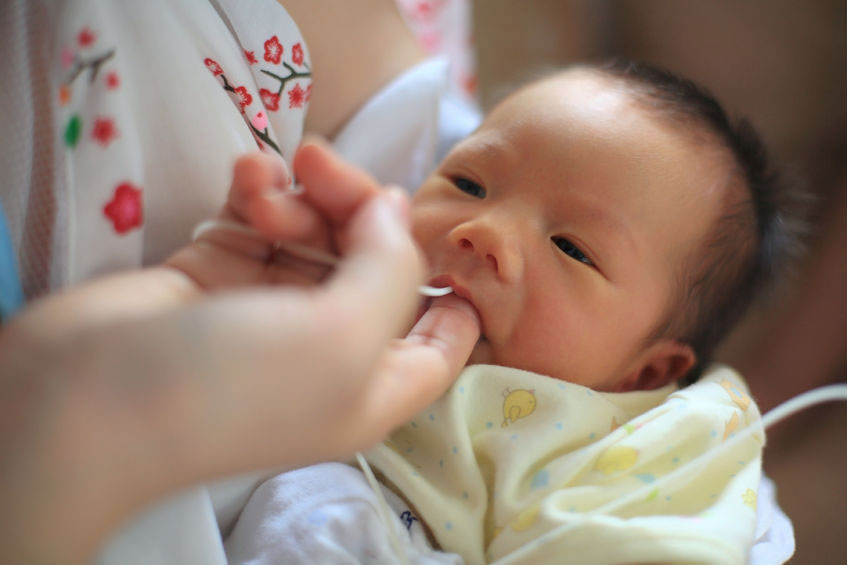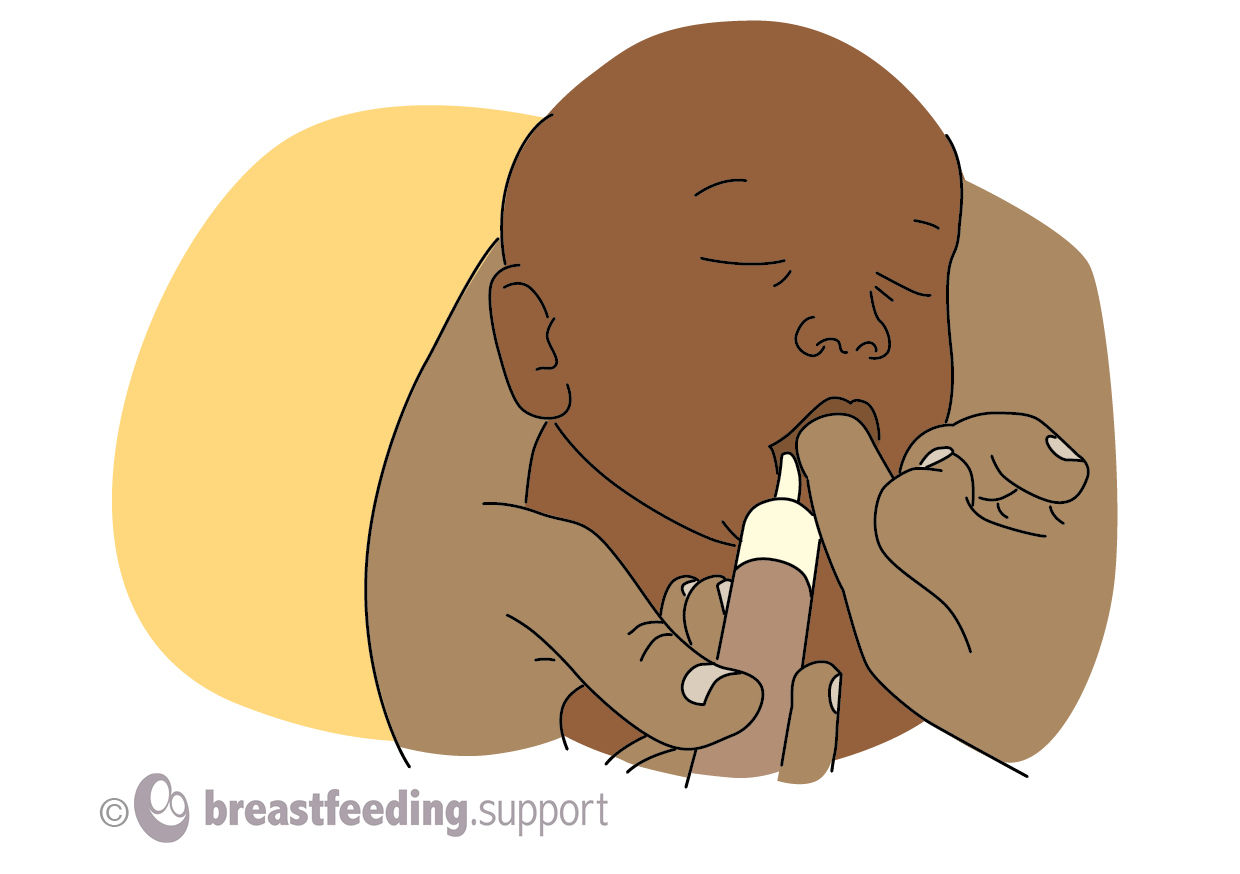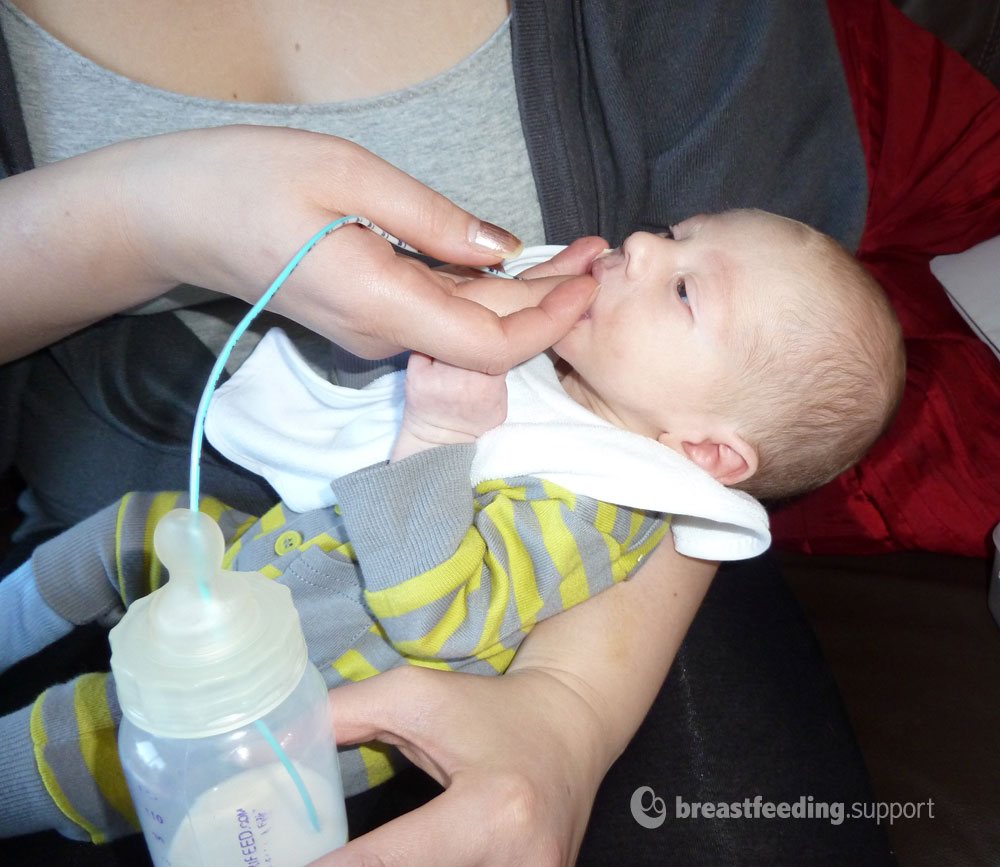Finger feeding involves a baby receiving breast milk or formula via a very narrow feeding tube while they suckle your finger. When a baby sucks on finger and tube together with their tongue in the right position, and with their lips making a seal on the finger, milk is drawn up the feeding tube from a container of milk. A curved tip syringe can also be used to drip milk into a baby’s mouth alongside the finger instead of a tube. Finger feeding is an alternative to using a bottle or cup if a baby needs a supplement and it can also be used as a suck training technique. This article looks at the ways finger feeding can be useful, how to do it, and the pros and cons with this technique.
Advantages of finger feeding
When a baby needs supplementary feeds, some authors feel that finger feeding may help to preserve the breastfeeding relationship compared to cup feeding or bottle feeding. Reasons include:
- Finger feeding uses a similar sucking technique to breastfeeding ie the same muscles are used and both methods allow the baby to control the flow of milk and pace the feed.1
- Finger feeding promotes skin-to-skin contact (between tongue and finger) and the finger tip reaches the same position deep in the mouth as the nipple (Wambach and Spencer, 2021).
- Finger feeding avoids introducing nipple confusion or bottle preference before breastfeeding is well established which can sometimes happen with the use of artificial teats. Note: Although there are differences between breastfeeding and bottle feeding, bottle preference and nipple confusion can be minimised by these Tips to Bottle Feed a Breastfed Baby and see Best Bottle for a Breastfed Baby? If used regularly, babies could equally have “finger preference” and reject the breast in favour of a finger feed.
When is finger feeding useful?
Finger feeding can be useful in a number of situations:
#1 To feed a baby
- Finger feeding keeps a baby well fed if they are not latching (attaching) to the breast, not breastfeeding well, or refusing a bottle.
- Separation from mother. If a breastfed baby is separated from their mother, finger feeding could be a feeding option to consider alongside cup feeding, syringe feeding or bottle feeding. One study of 53 babies showed preterm babies who were finger-fed had less milk loss, and fewer complications compared with cup feeding.2
#2 When baby won’t latch
- If a baby can’t latch to the breast yet, finger feeding may help to prepare a baby for breastfeeding3 because the sucking technique needed is similar to that which will be used at breast. For more reading see When Baby Won’t Breastfeed.
- Finger feeding can be used to wake up a non-latching sleepy newborn baby to give them some calories4 or to calm a hungry and frustrated baby and take the edge off their appetite before latching. Note: a baby who is very sleepy or has low stamina from being underweight may struggle to take adequate volumes with finger feeding as a sole method of supplementation and careful use of a bottle and teat may be more appropriate.
#3 Improving sucking skills
Because finger feeding has similarities to breastfeeding, finger feeding is sometimes suggested as a suck training technique to improve sucking skills or tongue function (see below).5 Finger feeding is said to reinforce good breastfeeding technique because:
- Baby has to keep his tongue down and forward in his mouth to cover his gums
- Baby uses a wide open mouth on the finger to recreate a deep latch—use your largest finger
- Baby has to suck actively to bring milk up the tube, just as he does at the breast to initiate a let-down (milk ejection reflex)
- Baby can control the flow of milk, if he doesn’t suck there will be a pause in milk flow
- Baby becomes familiar with the feel of skin in their mouth rather than a silicone teat.
#4 Respite from sore nipples
Finger feeding can be used for a day or two if a mother’s nipples are too sore and damaged to breastfeed to give them a chance to heal without introducing bottles. However, Jack Newman, a Canadian paediatrician and breastfeeding expert, cautions against interrupting breastfeeding unless absolutely necessary as sometimes a baby can be reluctant to go back to the breast.6 Breastfeeding can often continue uninterrupted with sore nipples once positioning has improved the latch. See Causes of Sore Nipples and Treatments for Sore Nipples for help for sore nipples.

Disadvantages of finger feeding
- Finger feeding is not appropriate for all babies. Some babies may find it difficult to get milk via the tube. Underweight babies may not have enough stamina to use the tube effectively. Alternatives include cup feeding or see our Tips to Bottle Feed a Breastfed Baby. If the baby can breastfeed, then additional milk can be given via feeding tube directly at the breast, see Supplementing at the Breast.
- Cleaning the tubes properly is difficult and could put your baby at risk of an infection. See Homemade Supplemental Nursing System for more information about cleaning homemade systems and see below.
- It can be quite awkward to finger feed especially if milk leaks in a homemade system and it can be difficult to source feeding tubes. Some babies figure out a way to suck on the tube like a straw rather than use a breastfeeding technique.
- The flow of milk may be too fast or too slow—however flow rate can be increased with a larger diameter tube, using two tubes, or by holding the container of milk above baby’s head. Flow can be decreased with a smaller diameter tube or lowering the position of the container.
- A sore mouth? If the tube is held on top of a finger it could rub against the roof of your baby’s mouth (the hard palate) potentially causing soreness. Having the tube running along the side of your finger may help so that the tube enters the corner of baby’s mouth instead of running across the hard palate.
- A finger is not the same as a breast, more research is needed on the safety and long term implications of finger feeding. For some babies finger feeding may negatively affect breastfeeding. Pushing a finger too far into baby’s mouth, or the tube extending further than a finger tip could cause gagging or discomfort. It’s important to watch your baby closely for signs of stress or they could start to resist anything entering their mouth—including a breast (oral aversion).

A step by step guide to finger feeding
Finger feeding is best shown in person by your IBCLC lactation consultant or health care professional. Detailed instructions for finger feeding can be found in Jack Newman’s article Finger and Cup Feeding or in Supporting Sucking Skills in Breastfeeding Infants or Breastfeeding and Human Lactation (2021. p 196). Information for using the Hazelbaker™ FingerFeeder can be found on fingerfeeder.com
The steps for finger feeding with a feeding tube include:
- Trim long finger nails and wash your hands prior to finger feeding.
- Hold your baby so that he can comfortably suckle your finger when it is held flat in his mouth. Baby’s head should be stable and slightly tilted back (Wambach and Spencer, 2021).
- Hold the rounded end of a small feeding tube (e.g. 5fr or 6fr) along the side of your finger or tape it in position if preferred, the end of the tube should be close to but not extend past your finger tip. Use a large finger or thumb to fill a baby’s mouth like the breast (Wambach and Spencer, 2021).
- Check that the opposite end of the tube is submerged in your expressed breast milk or formula and that the cap on this end of the tube is open.
- Encourage a wide gape—by brushing your finger against your baby’s lips. Never force a finger into your baby’s mouth always encourage the gaping reflex first.
- Slide your finger gently along your baby’s hard palate so that the soft pad of your finger tip is uppermost and resting against the roof of your baby’s mouth. Let your baby take your finger into his mouth as far as he is comfortable—avoid going too far to cause gagging or discomfort. Your baby will normally grasp the finger with his tongue and suck it deeply into his mouth so that the finger pad rests towards the back of his mouth at the junction of the hard and soft palates—some authors call this the “S-spot”.7 The nail side of your finger should be centred against the tongue. If your baby seems to gag on even your finger tip, contact your IBCLC lactation consultant.
- Check your baby’s lips are not folded in, the top lip should rest on your finger making a seal and the lower lip be turned out. Pull on the chin gently just enough to bring the lip out if it is tucked in. If baby doesn’t have good lip seal, milk may leak from the mouth.
- Try to keep your finger straight or flat to help encourage the correct tongue position and without applying pressure to the roof of your baby’s mouth, only maintain gentle contact. Good contact with the centre of baby’s tongue and his hard palate recreates the right position of the breast and nipple in baby’s mouth.
- Your baby will receive milk via the feeding tube at his own pace and the milk will gradually be drained from the bottle or container. Milk delivery is stopped when the tongue pulls back or the back of the tongue is humped against the finger, and resumed when the tongue tip is brought back over the gum ridge and the back of the tongue drops slightly. If your baby isn’t motivated to keep sucking long enough to draw milk up the tube, the tube can be prefilled with milk by inserting a blunt ended syringe of milk into the cap at the end of the tube.
- Monitor baby for signs of stress (frowning, finger splaying, turning away) and check whether they are coping well with organising sucking, swallowing and breathing when feeding with the tube in place. Check that the tube is not rubbing against the roof of your baby’s mouth.
Finger feeding variations with a syringe
- A blunt ended syringe can be used to house the supplement at the end of the feeding tube. The advantage of this system is that the feeder can slowly push the plunger down on the filled syringe to maintain a steady flow of milk when baby is sucking; pausing as needed for baby to swallow or rest.
- A curved tip syringe can also be used to introduce milk along your finger while baby suckles.
The disadvantage of using a syringe is that it can be difficult to hold baby and negotiate finger feeding and pushing the syringe at the same time without another pair of hands. The feed may need to be interrupted to refill the syringe and it is important to regulate the flow of milk carefully so as not to choke or overwhelm the baby.

Finger feeding for suck training
Suck training is when exercises are used to improve a baby’s immature or suboptimal sucking technique to help them breastfeed (or bottle feed) more effectively. This may involve stroking movements/massage of the tongue or gums and finger feeding can also be used as a suck training exercise. Advocates of suck training feel it can help to optimise feeding reflexes eg the way the tongue moves during feeding and familiarise a baby with the desired position of the nipple deep in baby’s mouth. Conversely, authors Wambach and Spencer point out that some practitioners feel that suck training is invasive and controlling and should never be used.8
There are many versions of suck training that individual therapists favour but no standard protocols (Wambach and Spencer, 2021 p80). Decisions on specific exercises are best discussed with speech and language therapists (SALT), your lactation consultant or see the latest editions of text books such as Breastfeeding and Human Lactation and Supporting Sucking Skills in Breastfeeding Infants for a detailed overview.
Cautions for suck training exercises
- Carry out suck training under the guidance of your IBCLC lactation consultant or other experienced health care professional eg a speech and language therapist (SALT). It is important to rule out positioning, attachment, mother’s anatomy, baby’s oral anatomy or even whether baby is very underweight to explain any breastfeeding issues before embarking on suck training. A therapist will choose appropriate exercises for specific suck issues.
- Mouth and tongue exercises should always be gentle and enjoyable for a baby. It’s important to be sensitive to your baby’s responses and stop an exercise if your baby is not enjoying it. Irritating your baby with intrusive exercises in his mouth could cause him to refuse anything in his mouth including a breast (called oral aversion).
- If finger feeding exercises don’t help or a baby doesn’t seem to enjoy the exercises, another strategy should be considered. Contact your IBCLC lactation consultant.
The need for a full assessment
Finger feeding can be used as a form of suck training to help improve the way the tongue moves during feeding and encourage the tongue forward in the baby’s mouth (tongue extension) (Watson Genna, 2017; Marmet and Shell, 1984). A baby who doesn’t bring his tongue forward to cup the breast will find it harder to maintain suction on the breast and if the tongue isn’t extended over the lower gum ridge during a breastfeed, the mother may feel a biting sensation or complain of sore nipples. However there can be many simple explanations for “biting” or soreness hence the need to first rule out other causes of sore nipples with your breastfeeding specialist such as poor positioning, shallow attachment at the breast, high muscle tone, fast-flow, tongue-tie or hunger, before using sucking exercises.
Where can I get a finger feeding supplementer?
It is possible to buy a purpose made finger feeder online called the Hazelbaker™ FingerFeeder (email aidanandevallc@gmail.com) or to use the tubes from a Medela Supplemental Nursing System. The instructions for making a homemade finger feeding tool for short term use can be found in Homemade Supplemental Nursing System. The equipment and the first four steps of “setting up” are the same as when making a homemade at-breast supplemental system.
Where can I get feeding tubes for a homemade system?
Your IBCLC lactation consultant may carry feeding tubes for finger feeding and plastic syringes to clean them, or they may know of a local supplier. Many medical suppliers in UK sell individually wrapped sterile feeding tubes (nasogastric tubes) by the box however it can be difficult for parents to source small numbers of tubes. Note: using a nasogastric tube for finger feeding is not using a device according to the manufacturer’s intended use. Nasogastric tubes are intended to carry milk to babies internally via the back of their nose and throat to the stomach. This means parents use tubes for finger feeding at their own risk without the protection of a manufacturer’s guarantee.
How can I clean the tubes?
While commercially made supplementers are made to withstand sterilising—disposable feeding tubes from a homemade system are not intended for reusing in this way and won’t stand up to boiling or steam sterilisation. See Homemade Supplemental Nursing System for cleaning information—tubes can be rinsed out straight after use by using a syringe in the end-cap to push cooled, previously boiled, water through the tube several times to remove milk.9 Some authors advocate flushing the tubes through with hot soapy water after removing the visible milk, and finally rinsing well.10 Residual water can be forced out of the tube by shaking the tube in a lasso action. Some mothers store washed tubes in a refrigerator between uses. Instructions for cleaning commercial devices will be supplied with the equipment or online e.g. see How Do I Clean the Hazelbaker™ FingerFeeder?
Replace tubes regularly
If you are using a disposable feeding tube it should be replaced with a new tube frequently, some mothers use a new tube each feed or every day. If they are cleaned thoroughly however, Dr Jack Newman 11 suggests tubes can be washed and reused for a few days before replacing.

Is long term finger feeding safe?
Finger feeding information does not seem to be based on any extensive research studies and relies on the experience of practitioners in the field who have used this technique. A breast widens a baby’s palate in a way that a bottle teat or finger can’t and tubes are difficult to clean properly. There is a risk of oral aversion if finger-feeding is not done respectfully. Until more research is available it would seem appropriate to limit finger feeding to short term use for encouraging a baby back to breast and suck training exercises under supervision. Alison Hazelbaker explains:
Breastfeeding still remains the ideal way to feed babies. Finger-feeding should be used only as a means to correct sucking problems or to keep the baby well fed until he or she can go to breast.
One study in Australia 12 found that finger-feeding as part of the feeding regimen ensured that a larger percentage of babies in the NICU were able to transition to breast successfully, whereas their bottle-feeding counterparts were less likely to do so. No other study has looked at finger-feeding.
Summary
Finger feeding is when a baby gets milk from a narrow feeding tube while they suckle on one of your fingers. Variations include dripping milk into baby’s mouth with a curved tip syringe while they suckle on a finger, or pushing milk along the feeding tube into baby’s mouth via a reservoir of milk in a syringe. Finger feeding a baby can be an alternative to using a bottle or cup if a baby isn’t breastfeeding yet or needs supplements, and it can also be used as a suck training technique to improve a baby’s sucking skills. There isn’t any substantial research on the safety of finger feeding and most information has been provided through the experience of lactation consultants who have used finger feeding in their work. It is recommended to carry out finger feeding under the guidance of your IBCLC lactation consultant or other health care professional.